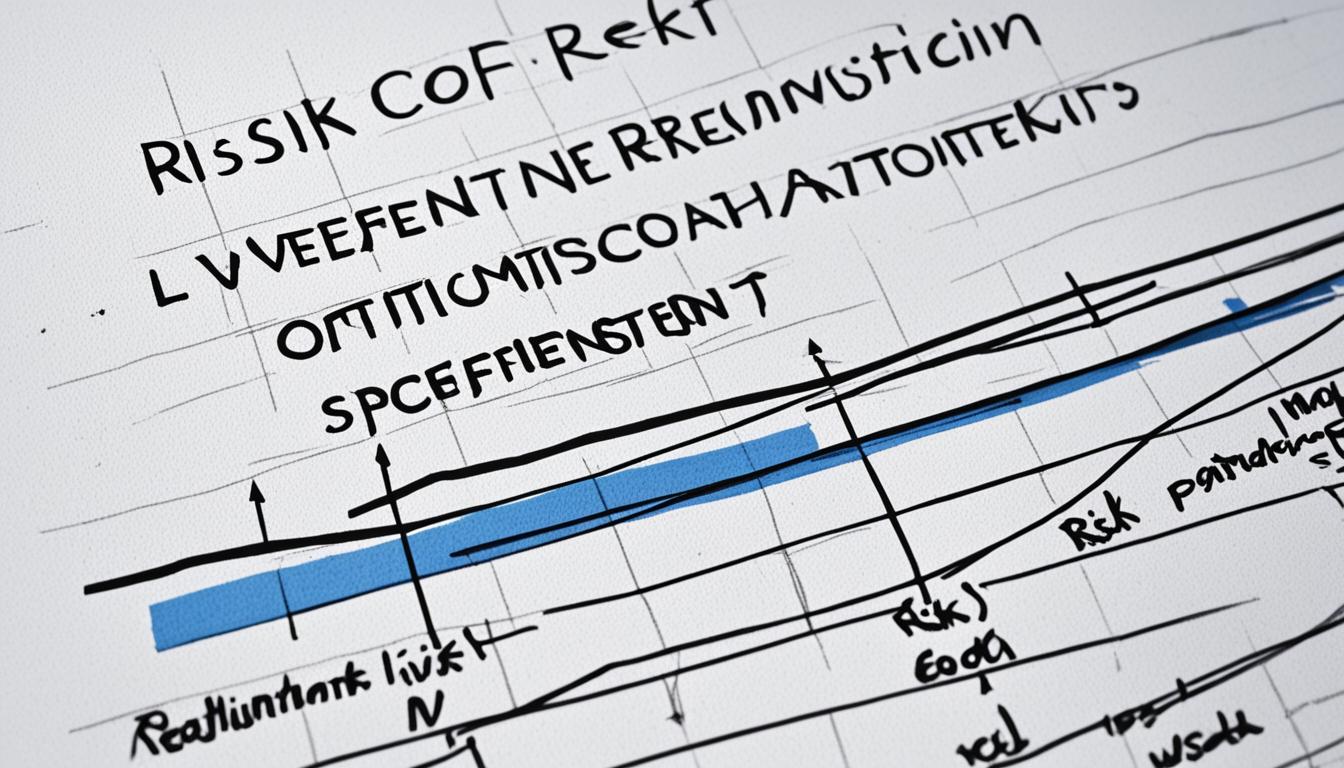The risk aversion coefficient plays a crucial role in financial portfolio optimization. It shows how much risk an investor is ready to handle when choosing investments. This factor is key in making plans that fit a person’s risk comfort and affects how well the portfolio does.
Grasping the importance of the risk aversion coefficient helps investors make portfolios that meet their financial goals without too much risk. This idea is central for making smart, educated choices in managing investment risks and portfolios.
Adding the risk aversion coefficient into the mix allows for a thoughtful way to pick assets. It finds a good middle ground between the earnings you hope for and the risk you’re okay with taking on.
Key Takeaways
- Risk aversion coefficient is crucial for aligning investment strategies with risk tolerance.
- Understanding this coefficient aids in balanced and informed portfolio decisions.
- It impacts the performance and risk level of financial portfolios.
- Knowledge of risk aversion supports effective investment risk analysis.
- Aids in achieving optimal balance between risk and returns in portfolio management.
Understanding the Risk Aversion Coefficient
Risk aversion is key when making smart financial plans. The risk aversion coefficient shows how much an investor avoids risk. This affects how they manage their portfolio and pick assets.
Definition and Importance
Risk aversion in investing shows how much someone doesn’t want to risk. This coefficient is crucial for judging how much risk someone can handle. It’s essential for creating a balanced investment portfolio. Such a portfolio weighs possible gains against the risk.
Calculating the Risk Aversion Coefficient
To figure out this coefficient, a few steps are needed. It involves looking at past data and how investors act to measure their risk comfort. Here’s a simplified method:
- Identify potential risk scenarios and their probabilities.
- Assess the potential losses or gains for each scenario.
- Apply quantitative models to estimate the coefficient using past and future data.
Factors Influencing Risk Aversion
Various factors can change how risk-averse an investor is. These factors can be personal, like age or financial status. Economic conditions and global events also play a role. This makes managing portfolio risk an ever-changing task.
Role of Risk Aversion in Investing
Risk aversion plays a big role in making investment choices. It affects how investors balance the trade-off between risk and reward. This shapes what assets they pick and how they structure their portfolios.
Impact on Investment Decisions
An investor’s willingness to take risks shapes their portfolio. Those who dislike risk often choose safer assets like bonds or money market funds. On the flip side, risk-takers might go for stocks or alternate investments for bigger potential gains.
Differentiating Between Risk Preferences
It’s key to know and distinguish between different risk preferences. Each type of investor, from cautious to bold, has distinct traits. These traits help in crafting their investment strategy. A cautious investor might aim for the safest path, willing to get lower returns. Meanwhile, a bold investor seeks high returns despite the risk of big ups and downs.
Examples in Portfolio Selection
Let’s see how risk aversion affects choosing a portfolio:
- A highly risk-averse investor might go for 60% bonds, 30% blue-chip stocks, and 10% cash.
- A moderately risk-averse person might choose 50% stocks, 30% bonds, and 20% in REITs.
- An aggressive investor may prefer 80% stocks, 15% aggressive growth ETFs, and 5% cryptocurrencies.
These examples demonstrate how risk tolerance influences an efficient portfolio. It ensures investors’ risk preferences are well-represented.
Application in Modern Portfolio Theory
Using the Modern Portfolio Theory (MPT), investors can create strategies. These strategies balance risk and return. MPT helps us see how risk aversion affects where investors fall on the efficient frontier.
Efficient Frontier and Risk Aversion
The efficient frontier is about finding the best portfolios. These portfolios give the highest return for a certain risk level. Your spot on the frontier depends on how much risk you’re willing to take.
People who dislike risk pick lower-risk portfolios for safety. Those okay with risk go for higher-return portfolios.
Balancing Risk and Return
Portfolio management tries to balance risk and return. MPT allows investors to adjust their portfolios to fit their risk levels. This balance is found by choosing different assets and tweaking often.
Investors must watch the market and see if their risk tolerance changes. This helps keep their portfolio in a good spot.
Portfolio Diversification Strategy
A portfolio diversification strategy is crucial. It helps lower risks that come with different investments. By spreading out investments, one bad performance won’t hurt too much.
This strategy sticks to MPT and aims to balance risk and return. It makes portfolios stronger against market ups and downs, leading to steadier returns.
| Risk Level | Investment Strategy | Expected Return |
|---|---|---|
| Low Risk | Bonds, Stable Blue-Chip Stocks | Modest but Stable |
| Moderate Risk | Mixed Equities, Balanced Funds | Moderate and Well-Balanced |
| High Risk | Growth Stocks, Commodities | High but Volatile |
MPT gives investors tools to aim for the best portfolio performance. By balancing risk and return and using diversification, they can tackle financial market challenges confidently.
Risk Aversion Coefficient Portfolio Optimization
The process of risk aversion coefficient portfolio optimization helps investors match their portfolios to their risk levels. The risk aversion coefficient measures how to make investment choices wisely. It helps keep a balance in managing portfolio risk and gaining the best returns within accepted risk limits.
Let’s look at how the risk aversion coefficient affects portfolio optimization:
- Setting Risk Tolerance: Using the risk aversion coefficient helps create financial plans suited to investor preferences.
- Asset Allocation: It helps suggest how much to invest in various asset types, aiming for the best balance.
- Performance Evaluation: Regularly checking if a portfolio meets risk tolerance helps stick to portfolio risk management rules.
The risk aversion coefficient plays a big part in improving financial portfolio optimization:
| Parameter | Impact on Portfolio |
|---|---|
| Risk Tolerance | Sets the max loss limit, guiding where to invest. |
| Expected Return | Tunes expected gains to fit the investor’s risk level. |
| Asset Allocation | Plans out which mix of investments to go for, considering risks. |
| Market Conditions | Changes strategies based on current markets, using the risk aversion coefficient. |
Knowing these points highlights the risk aversion coefficient’s key role in portfolio risk management. In short, this tool is vital for creating investment strategies that meet financial portfolio optimization goals. It makes sure an investor’s portfolio can withstand different markets while staying true to personal risk preferences.
Conclusion
As we end our journey into the role of risk aversion in investing, we find knowledge is key. Understanding your risk comfort helps tailor your investment strategy. This insight shapes how we manage and assess risks in our portfolios.
By using Modern Portfolio Theory, or MPT, we balance risk and reward better. This balance helps us aim for higher returns while keeping risks low. It’s all about finding the right mix to grow your wealth safely.
Knowing about the risk aversion coefficient is crucial for smart investing. It helps make choices that fit your risk level. With this knowledge, investors can face the financial world boldly. This forms a strong base for building wealth over time.
FAQ
What is the risk aversion coefficient in portfolio optimization?
The risk aversion coefficient measures an investor’s risk tolerance. It’s key in financial portfolio optimization. It ties investment strategies to an investor’s risk comfort. This ensures a good balance between possible returns and acceptable risks.
How is the risk aversion coefficient calculated?
It’s calculated using math models that consider an investor’s utility function. This function shows their risk vs. return preference. It’s often based on past data, surveys, and theories like modern portfolio theory.
Why is the risk aversion coefficient important in investing?
Knowing the risk aversion coefficient is critical for risk analysis in investments. It helps investors find investments that match their risk tolerance. This is vital for reaching long-term financial goals and managing potential risks.
What factors influence an individual’s level of risk aversion?
Many factors impact investing risk aversion. These include personal factors like age, income, and goals. Economic conditions and market trends also play a role. These can affect an individual’s investment strategy and tolerance for risk over time.
How does risk aversion affect investment decisions?
Risk aversion guides portfolio risk management and asset selection. Investors who are more risk-averse usually choose safer, less-return investments. Those less afraid of risk may pick higher-risk, higher-return options.
Can you give an example of risk aversion in portfolio selection?
For example, a risk-averse investor might put more into bonds and stocks that pay dividends to reduce volatility. A less cautious investor might prefer growth stocks or alternative investments for higher returns.
What is the efficient frontier in the context of risk aversion?
The efficient frontier is a key concept in portfolio theory. It shows optimal portfolios with the best expected return for a certain risk level. It underscores the risk aversion coefficient’s role in picking efficient risk-return investments.
How can investors balance risk and return in their portfolios?
Investors balance risk and return by diversifying across different asset types. This diversification reduces risk. It keeps the overall portfolio stable, even if some investments don’t do well.
What role does the risk aversion coefficient play in modern portfolio theory?
In modern portfolio theory, the risk aversion coefficient is key for finding an investor’s most efficient portfolio. It identifies the best asset mix to maximize return for a certain risk, fitting the investor’s risk profile.
How can risk aversion coefficients be used in financial portfolio optimization?
Risk aversion coefficients are used to customize investment strategies to an investor’s risk preferences. They help investors manage portfolio risk better. This improves their chances of reaching financial goals while keeping performance volatility at an acceptable level.






